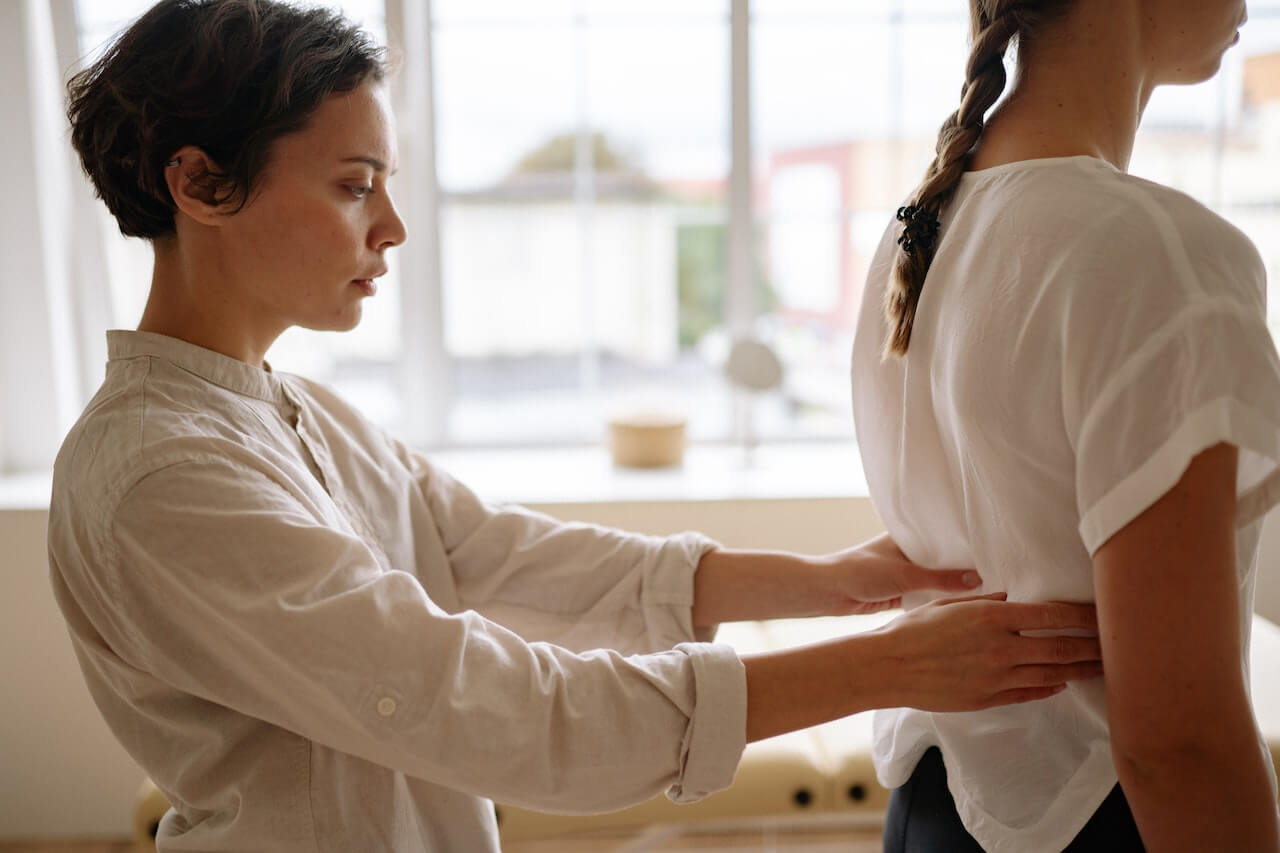Pregnancy-related pelvic girdle pain is mild to severe pain in the front and/or back of your pelvis that may also affect your hips, sacroiliac joints, thighs, and knees.
It is also called symphysis pubis dysfunction (SPD).
It is common in pregnant women. One in five pregnant women suffer from pelvic girdle pain (PGP).

Causes of pregnancy-related pelvic girdle pain
During pregnancy, ligaments in the pelvic area become more relaxed and other joints become more mobile which may lead to pain in the pelvic area.
The three joints in the pelvis move unevenly, so the pelvic girdle becomes less stable and painful. 1 in 5 pregnant women may develop PGP with different degrees.
You have a big chance of getting pregnancy-related pelvic girdle pain:
- If you already have back problems.
- Have hypermobility syndrome.
- Had a back injury in the past.
- Are overweight.
- Do a physically demanding job.
Pregnancy-related pelvic girdle pain may develop at any stage in pregnancy, labor, or after birth.
Although pelvic girdle pain (PGP) may be excruciating for you, it will not affect your baby's health.
Diagnosis of pelvic girdle pain
Early diagnosis and treatment of pregnancy-related pelvic girdle pain prevent the symptoms from getting worse, reduce your pain, and help you do your daily activities normally.
Describe your pain to your doctor. Contact a physiotherapist who can diagnose your pelvic girdle pain and help you to be good.
The posterior pelvic pain provocation test (pppp test or P4 test) is used to detect the existence of sacroiliac dysfunction. Also to differentiate between pelvic girdle pain and lower back pain.
Symptoms of pelvic girdle pain
Pelvic girdle pain is a combination of uncomfortable symptoms that may limit your daily activities, caused by the hardness of pelvic joints or uneven movement.
You may:
- Feel pain in pelvic joints and hips.
- Feel pain in the pubic region, knees, and thighs.
- Feel pain while climbing stairs.
- Hear clicking in the pelvic region.
- Find difficulty while walking or turning over in bed.
The degree of pain is different in each person, it may be mild or severe.

What can help your symptoms?
Pregnancy-related pelvic girdle pain symptoms may worsen with movement so you need to follow these steps:
- Do your activities but also take plenty of rest.
- Stand tall all the time.
- Sit tall with back support.
- Change your position always. Don't stand for more than 30 minutes.
- Use a pillow between your legs for more support.
- Sleep on the less painful side.
Treatment of pregnancy-related pelvic girdle pain
There are several techniques you can follow to control and manage your pregnancy-related pelvic girdle pain.
- Identify what daily activities cause your pain and try to avoid it as much as you can.
For example, avoid wearing high-heeled shoes, avoid standing on one leg, avoid sitting or standing for long times, and reduce climbing stairs.
- Wearing pelvic support belts can stabilize your pelvic girdle and improve the symptoms if you fit well and wear them for short times.
- Ask the doctor or pharmacist about medicines that help you control your pain and continue with your daily activities.
- Physiotherapy aims to relieve pain and enhance muscle function.
Physiotherapy includes exercises to strengthen pelvic, back, and hip muscles.
A physiotherapist can teach you some practices that you can do at home to manage your pain.
- If your pain is severe and not improving you may need specialist pain management services.
Pregnancy-related pelvic girdle pain is often relieved without treatment after birth. However, it may occur again in future pregnancies.
You can manage your pelvic girdle pain at home. A physiotherapist can suggest an exercise program to do at home that helps you manage your pain.
If your pain prevents you from doing your daily activities, you can take a pain relief drug like paracetamol.
Pain relief drugs can help you to do your exercises easily.
Also, applying heat to painful areas may help you. Taking bed rest also helps but not for a long time.
If you feel that you need extended bed rest during pregnancy, ask your doctor first.

Pregnancy-related pelvic girdle pain and birth
Talk about your birth plan with your doctor or midwife and tell them that you have pelvic girdle pain, so they will be aware of your case and can help you during labor and birth.
Choose the birth position that is the most comfortable for you and puts less strain on your hips and pelvis.
Think about water birth. It can take the weight off the joints and ease your movement.
Most pregnant women with pelvic girdle pain can have vaginal labor but in some cases with severe PGP caesarian section is an option.
Not all women with pregnancy-related pelvic girdle pain will develop it in future pregnancies. 7 out of 10 women with pelvic girdle pain during pregnancy may have PGP again in future pregnancies.
Managing your pregnancy-related pelvic girdle pain early prevents your pain from worsening while your pregnancy advances.
Backache during pregnancy
Another pregnancy-related condition is backache.
Hormonal changes in pregnancy cause your body's ligaments to relax preparing for labor. This can strain your joints in the lower back causing backache.
Also, the weight of your growing baby may cause lower back pain.
You can protect yourself from backache during pregnancy by avoiding habits and activities that pain your back.
Backache during pregnancy can be treated with simple exercises and wearing back support.
A herniated disc is a very rare disorder that may occur in pregnant women.
Summary
Pregnancy-related pelvic girdle pain is a simple condition that can't affect your baby's health or your labor. However, it affects your daily routine and makes you feel uncomfortable.
It is easy to control and treat your pregnancy-related pelvic girdle pain.
Follow your doctor's guidance, avoid activities that cause your pain, and contact a physiotherapist who can help you manage your pain.
Read more about:


You must be logged in to post a comment.